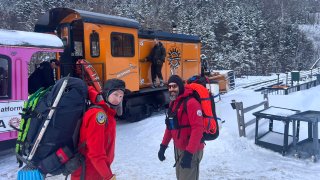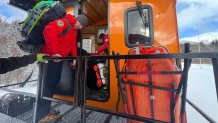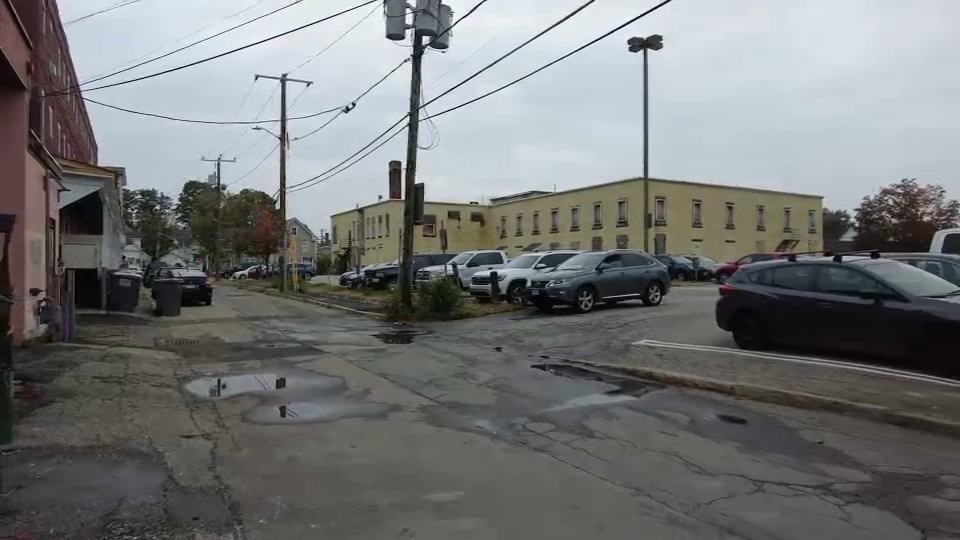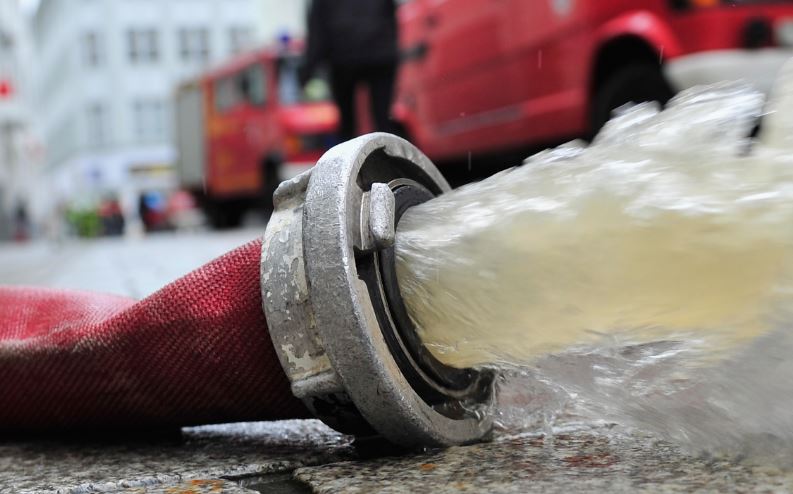
In this image provided by New Hampshire Fish and Game, New Hampshire Fish and Game conservation officer Levi Frye, left, and Jeremy Broughton, from Androscoggin Valley Search and Rescue, prepare to head out on a rescue mission at the Cog Railway base station, Saturday, Feb. 17, 2024, in Mount Washington, N.H. A team of rescuers used the Cog Railway to shave off time but it still took more than 10 hours to save a hiker in conditions that included sustained winds topping 90 mph (145 kph) on New Hampshire’s Mount Washington, officials said.
As temperatures plunged on Mount Washington and ferocious winds made it near impossible to see, hiker Cole Matthes began to drift away from the trail. Then he hit a patch of snow-covered ice and slid hundreds of feet down a ravine.
WATCH ANYTIME FOR FREE
>Stream NBC10 Boston news for free, 24/7, wherever you are. |
Both Matthes and the rescuers agree that without help, he would have died within hours.
“I am extremely grateful to all 11 of the men who saved my life Saturday and am also extremely sorry that they had to risk their lives to save me,” Matthes told The Associated Press. “I certainly made poor decisions and was underprepared for this hike.”
Get updates on what's happening in Boston to your inbox. Sign up for our >News Headlines newsletter.
Matthes, a 22-year-old engineer from Portsmouth, New Hampshire, said in an online interview that he has plenty of hiking experience but not during harsh winter conditions. He set off in spiked snowshoes planning to complete the challenging 9-mile Ammonoosuc Ravine Trail loop, which has an elevation gain of 4,200 feet.
New Hampshire Fish and Game said that as conditions worsened, Matthes ignored advice from other hikers to turn back.
“While I did see a group of hikers turn around at the Lake of the Clouds Hut, I decided to continue with other hikers,” Matthes said. “I was not hiking alone at that point and the weather conditions had not reached their peak.”
Once above the tree line, Matthes said, he swapped his snowshoes for boots with micro spikes because the snow wasn’t deep and it was easier to navigate the rocks and ridges. But then he lost visibility. He slid down the ravine a little before noon, banging himself up and twisting his ankle. He called 911.

Ryan Presby, who manages the Mount Washington Cog Railway, said he took the train up three times with rescue crews. As winds hit 90 miles per hour and temperatures plunged, he worried the train’s diesel fuel would gel and the engine seize. He told rescuers to jump out as quickly as possible when they reached their destination.
Levi Frye, a conservation officer with Fish and Game, was one of the first group of three rescuers to jump off the train. He said it was immediately clear they needed crampons for the ice and fierce wind.
“We were fighting it the whole time. It was certainly capable of knocking you off your feet, especially with a heavy pack on,” Frye said. “The visibility was so bad on account of all the snow getting blown around.”
The trail was marked with rock cairns, Frye said. Because the visibility was so poor, they used a system called leapfrogging. One person would stay at the first cairn while another would try to locate the next cairn. The third person stood in the middle to keep contact with both.
Staying safe meant finding a balance between not getting too cold and not sweating too much, because it was even more dangerous to have sweat freeze, Frye said.
After several hours in the ravine, Matthes said, there was a lull in the wind, and he spotted the Lake of the Clouds Hut in the distance. Although sore, his legs and ankle could take his weight. He was able to climb back up the ridge and make it to the closed hut, taking shelter underneath in an emergency spot rescuers call the cave. He called 911 again to update his location.
Huddling together to block the wind, Frye and his companions got the message. By the time they reached Matthes a little after 6 p.m., it was already dark.
“I was extremely relieved once the first team of rescuers arrived,” Matthes said. “Even with my shelter, I wouldn’t have lasted through the night in my condition.”
Matthes’s boots were frozen solid, Frye said. The top priority was to strip him of his wet gear and get him into dry clothes. They gave him warm water and electrolytes and strapped his ankle as more rescuers arrived. By about 9:30 p.m., they felt he was stable and ready to leave.
“He was very willing to try to hike out,” Frye said. “We ended up having him connected to another rescuer who had a harness on him.”
The first few hundred yards were rough, Frye said. But once they got below the tree line, they got more protection from the wind. They got back to base a little before 11 p.m.
After being treated, Matthes said he declined the advice from rescuers to take an ambulance to the hospital because he thought it would be expensive. He drove himself there instead.
“I’m currently recovering from some frostbite on my toes,” Matthes said.
New Hampshire Fish and Game said Matthes didn’t have proper gear or equipment, didn’t plan for the weather or make good decisions. In the past, the agency has sought to recover rescue costs from some hikers they consider negligent. The agency said it hasn’t yet made a decision on the Matthes rescue.
Matthes said he was aware of the possible financial implications when he first called 911.
“But I knew that if I hadn’t called for help, I wouldn’t have made it down,” Matthes said. “At the end of the day, I’m alive, and that’s all that I could ask for.”




